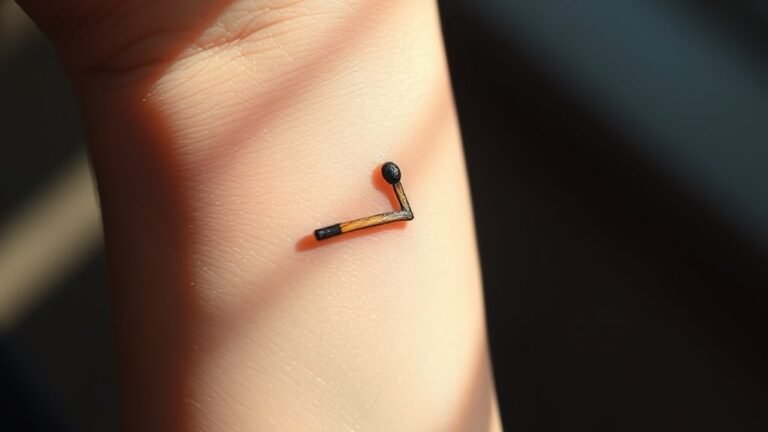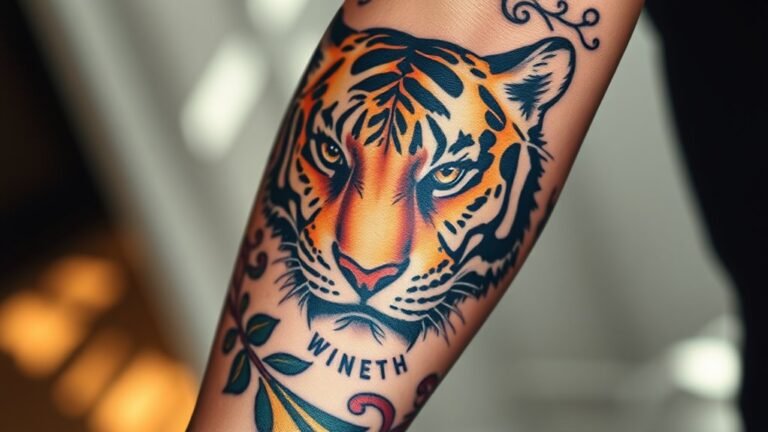Jelly Roll Face Tattoo Meaning and Symbolism
When you look at a Jelly Roll face tattoo, you might see more than just ink; you see a story etched into skin. Each design whispers a tale of resilience, identity, and cultural heritage. As you explore the meanings behind these intricate artworks, you'll uncover the layers of personal journeys and communal ties that shape them. What do these tattoos reveal about the individuals who wear them, and how do they challenge societal norms?
In a Nutshell
- Jelly Roll face tattoos symbolize personal journeys, with each curl representing transformative experiences and milestones in the wearer's life.
- The designs reflect a deep connection to cultural heritage, serving as a badge of identity linked to community roots and beliefs.
- Artistic expression in jelly roll tattoos showcases individuality, allowing wearers to incorporate elements from various styles and personal inspirations.
- These tattoos challenge societal perceptions, fostering empowerment and creating a sense of belonging among individuals with similar life experiences.
- The intricate patterns and bold imagery in jelly roll tattoos invite storytelling, connecting wearers to their lineage and the artistry of their culture.
Historical Context of Jelly Roll Face Tattoos
Although you might associate face tattoos with modern trends, the history of Jelly Roll face tattoos reveals a rich tapestry of cultural significance and personal expression.
These tattoos trace their historical origins back to various indigenous cultures where body art symbolized identity, status, and rites of passage. As tattoo evolution unfolded, Jelly Roll designs emerged, often featuring intricate patterns and bold imagery, reflecting individuality and resilience.
You may find that these tattoos serve as a canvas for storytelling, connecting you with a lineage of artistry that spans generations. Embracing this vibrant history, you're not just marking your skin; you're intertwining your narrative with those who came before, creating a sense of belonging that transcends time and trends.
Cultural Significance in Different Communities
As you explore the cultural significance of Jelly Roll face tattoos, you'll discover that they resonate differently across various communities, each breathing life into unique interpretations and meanings.
In some cultures, these tattoos symbolize resilience and a connection to one's roots, reflecting community beliefs that honor personal stories and struggles.
Others view them as artistic expressions, celebrating cultural variations in style and design.
Through these tattoos, individuals find a sense of belonging, bonding over shared experiences and values.
The Jelly Roll tattoo transforms into a badge of identity, reminding wearers of their heritage and the strength of their community.
It's not just ink; it's a narrative woven into the fabric of culture, uniting those who embrace its significance.
Personal Stories Behind Jelly Roll Tattoos
Jelly Roll tattoos often carry personal stories that reveal the depth of the wearer's journey. Each inked curl might symbolize a transformative experience, a moment that shifted your perspective or ignited a passion.
Maybe it represents your personal motivations—overcoming challenges, embracing your identity, or celebrating resilience.
As you gaze at your tattoo, you're reminded of the struggles and triumphs that shaped you. It's more than just art; it's a narrative etched into your skin, connecting you to a community of others who share similar paths.
This bond fosters a sense of belonging, where every swirl and line speaks to the authenticity of your life's journey. In this way, Jelly Roll tattoos become a powerful reflection of who you are.
Artistic Expression and Design Choices
When choosing a design for a Jelly Roll face tattoo, you embrace a canvas that speaks to your individuality and artistic flair.
Your design inspirations can draw from various styles—graffiti, traditional, or even abstract. Consider how artistic techniques like dot work, line art, or shading can elevate your tattoo's impact.
Each choice you make reflects your personality, telling a unique story that resonates with others. As you explore motifs, think about what connects you to your community; perhaps it's a shared love for music, culture, or personal experiences.
Ultimately, this tattoo becomes more than just ink; it's a bold expression of who you are, a declaration that invites others to appreciate your journey and creativity.
The Symbolism of Colors in Jelly Roll Tattoos
Choosing the right colors for your Jelly Roll face tattoo can add layers of meaning and emotion to your design.
Each hue carries its own significance, making your choice a profound expression of your identity.
Here's a quick guide to color meanings in tattoo symbolism:
- Red: Passion and love, showcasing your fiery spirit.
- Blue: Calmness and tranquility, reflecting inner peace.
- Green: Growth and renewal, symbolizing transformation.
- Yellow: Happiness and optimism, radiating positive energy.
- Black: Strength and resilience, representing your journey.
Psychological Impact of Face Tattoos
Although face tattoos can be a bold form of self-expression, they often carry a complex psychological impact that extends beyond mere aesthetics. When you choose to ink your face, you're not just making a statement; you're exploring deep layers of your identity.
The psychological effects can be profound, as your tattoo becomes a canvas for your personal narrative, a way to manifest your inner self to the outside world. This identity expression can foster a sense of belonging within certain communities, offering connection and solidarity.
Yet, it might also challenge you to confront societal perceptions and internal conflicts. Ultimately, wearing your story on your face invites both empowerment and vulnerability, shaping how you see yourself and how others see you.
Reactions and Stigmas Surrounding Face Tattoos
The boldness of face tattoos often leads to a whirlwind of reactions, reflecting both personal expression and societal norms. While you might see your tattoo as a badge of individuality, others may react with skepticism or disapproval, revealing deep-rooted social perceptions.
This stigma can weigh heavily, but there's hope for stigma reduction as awareness grows.
Here are some common reactions you might encounter:
- Admiration for courage and creativity
- Misunderstanding or prejudice
- Curiosity about the meaning behind the tattoo
- Fear of judgment from others
- Conversations about acceptance and change
Navigating these reactions can be challenging, but embracing your choice can foster connections with those who appreciate your unique narrative.
Famous Personalities With Jelly Roll Face Tattoos
While face tattoos often spark debate, some famous personalities embrace them as a canvas for their stories, with Jelly Roll leading the charge.
You'll find that many renowned musicians and celebrity influencers wear their Jelly Roll face tattoos proudly, turning heads and inviting conversations. Each inked line tells a tale of struggle, triumph, or identity.
For instance, Jelly Roll himself, a rising star in the music scene, showcases his unique artistry, making his mark not just in sound but in visual expression as well.
Others, like Post Malone and Lil Wayne, have also embraced this trend, blending their artistry into their skin.
These personalities remind us that tattoos can foster connection, inspiring those who seek a sense of belonging and authenticity.
Caring for Your Jelly Roll Face Tattoo
Caring for your Jelly Roll face tattoo is essential to guarantee its vibrancy and longevity, especially since facial ink can be more susceptible to fading and irritation.
To keep your tattoo looking fresh, you'll want to establish solid aftercare routines and skin maintenance. Here are five key tips:
- Keep it clean: Gently wash your tattoo with mild soap daily.
- Moisturize: Use a fragrance-free lotion to keep the skin hydrated.
- Avoid sun exposure: Protect your tattoo with sunscreen to prevent fading.
- Don't pick: Resist the urge to scratch or pick at scabs.
- Stay hydrated: Drink plenty of water to maintain skin elasticity.
Frequently Asked Questions
Are There Specific Pain Levels Associated With Getting a Face Tattoo?
Getting a face tattoo can vary in pain depending on your pain tolerance. Areas with less flesh and more bone can sting. Remember, the healing process often brings its own discomfort, so prepare yourself mentally!
How Do I Choose the Right Tattoo Artist for a Jelly Roll Tattoo?
Choosing the right tattoo artist starts with reviewing their portfolio. Look for styles that resonate with you. During the artist consultation, ask questions and share your vision—they'll help you feel confident in your choice.
Can Jelly Roll Tattoos Be Easily Covered up or Removed?
Yes, jelly roll tattoos can be covered up or removed. Tattoo removal techniques, like laser treatments, exist, while creative cover-up options allow you to transform your ink into something new, reflecting your evolving self.
What Are the Best Aftercare Products for Face Tattoos?
When caring for your fresh face tattoo, use healing ointments to soothe irritation and tattoo moisturizers to keep the skin hydrated. These products help guarantee your ink heals beautifully while fostering a sense of belonging in your skin.
Are Jelly Roll Tattoos More Accepted in Certain Professions or Industries?
Jelly Roll tattoos often face varied professional acceptance. In creative fields, they're celebrated as expressions of individuality, while traditional industries may still hesitate. Your choice reflects your identity, but understanding industry norms can guide your decision.







